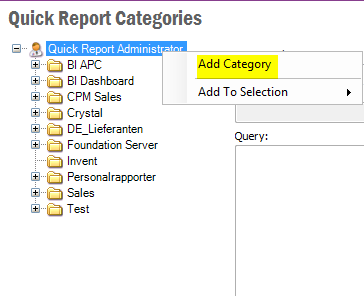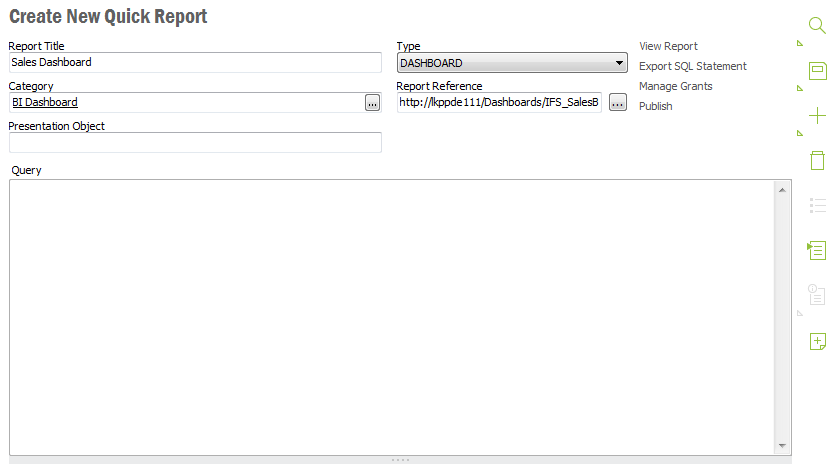Dashboards
Following sections provides help for creating, saving, publishing and managing
dashboards.
Contents
Before you can manage and save a report as a dashboard, the Dashboards folder
in Report Manager must have been created. Check the Configuration of Report Manager
in the installation section for more information
>>.
A report publisher can create subfolders in the Dashboard directory and create
a folder structure to arrange reports as needed. This is recommended if the number
of dashboards is high.
To manage dashboards in Report Manager:
- Open the Dashboards folder in Report Manager and click
the New Folder. Specify the name of the folder and give an appropriate
description. Security settings of a newly created folder will
be inherited from the top folder by default. E.g., all report users that have permissions
to view the Dashboards folder, will also have permissions to view reports saved in
the subfolders.
The name and description of an existing folder can be modified through the
General Properties page of the folder.
When saving a report as a dashboard, it can be saved in the Dashboard top folder
or in any of the subfolders.
When defining a dashboard as a Quick Report in IFS EE the report must be connected
to a quick report category and a quick report type. The report publisher defines
the quick report categories needed for dashboards. If the number of dashboards
is
high it is recommended to save the report in categories that will facilitate for
the report viewers to locate the dashboards.
To add a quick report category in IFS EE:
- Open Business Reporting & Analysis/Administer Quick Reports/Ad-hoc/Quick Reports Categories
page in IFS Enterprise Explorer.
- Select Quick Report Administrator, right-click and click Add
Category.
- Type an appropriate report category name. To distinguish the dashboards
from other Quick Reports, it can be advisable to start the report category
name with e.g. BI or AM

Figure 1: Define a Quick Report category
There is a system defined quick report type named DASHBOARD for the purpose
of defining dashboards as quick reports in IFS EE.
To create a dashboard reports:
-
Go to IFS Enterprise Explorer. Click Report
Builder in Business Reporting & Analysis/My Reports
page, to start Microsoft Report Builder 3.0 and create a blank report.
-
Create a data source and a dataset as mentioned in
Data sources and Datasets section.
-
Plan a dashboard report to decide which data you are going to present
and what visualization items will be used.
-
Create the dashboard in Report Builder by using charts, gauges,
indicators etc. Refer to
Getting Started
section and the example dashboard reports described below the
Report Design section.
In order to save a report in the Dashboards folder, you must belong to
the Report Publisher user group.
To save a dashboard in Report Manager
- Click Report Builder and then Save As, to save the report in the report server.
- Select Recent Sites and Servers. Select
or enter the name of the report server and select
Dashboards folder to save the report. Type a name for the report
and click Save. A report can also be saved
in a subfolder to the Dashboards folder.
To define and publish a dashboard in IFS EE you must have permissions to use Quick
Reports in IFS Solution Manager.
- Open the Business Reporting & Analysis/Administer Quick Reports/Create New
Quick Report
page in IFS Enterprise Explorer.
- Click New.
-
Follow the procedure below to define a Report
Builder dashboard as a quick report.
- Enter a report title and select DASHBOARD as the report
type.
- Select a category.
- Open the Add Report Reference dialog by clicking the button next
to the Report Reference field. Add a value to the Report Reference by
choosing a dashboard in the dialog.
- You may also add comments to the report in the Comments
field. The presentation object is automatically generated when you publish
the dashboard.
- Click Save.

Figure 2: Quick report definitions for a Report Builder dashboard.
- Follow the procedure below to define a Web Dashboard as a
quick report.
- Enter a report title and select
DASHBOARD as the report type
- Select a category
- Enter a hyperlink of a web dashboard in the
Report Reference field
- You may also add comments in the Comments
filed. Click Save and then click Publish to automatically
generate presentation object for the quick report.

Figure 3: Quick report definitions for a web dashboard,
- For end users to execute the report they must be granted access to the
report. One way to do this is to click on the Publish link in the
report detail header.
For more information on granting permission to dashboards and other ways of
publishing reports, check the IFS Applications Technical documentation.
To access a Dashboard:
- Open the Business Reporting & Analysis/Published Content/Dashboards
page in IFS Enterprise Explorer. All available dashboards will be listed.
- Click on a dashboard name.
- The dashboard will be generated and opened.
You can also find the dashboards categorized under
DASHBOARD type in Business Reporting & Analysis/Explore Quick Reports/By
Types.



